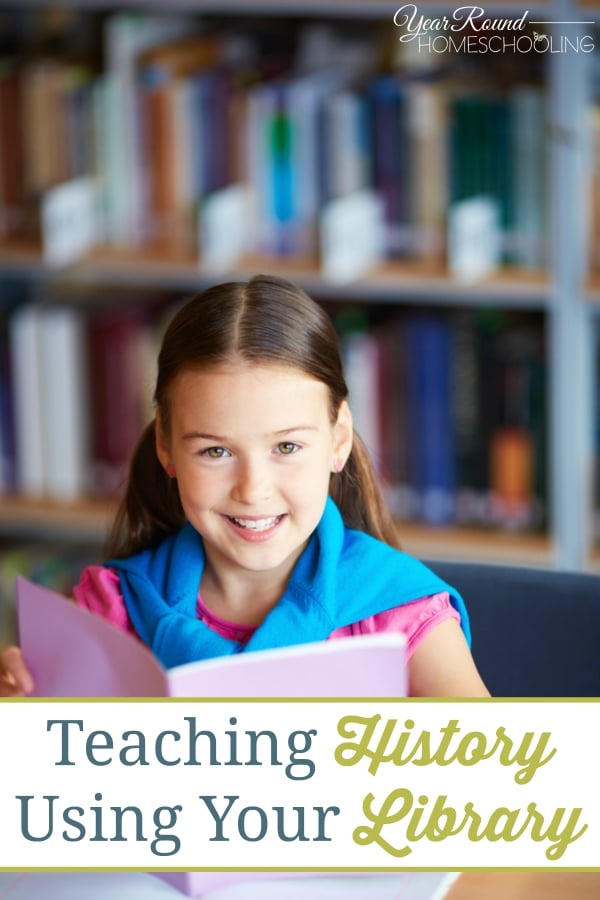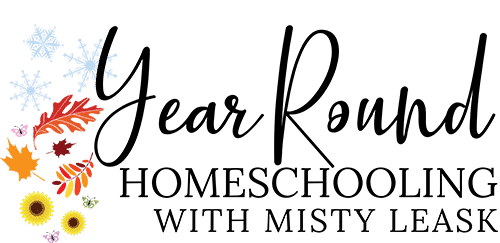In my last post, Teaching History Basics, I talked about principles and guidelines to keep in mind when teaching history in homeschooling. In this post we will look at one of the easiest and cheapest way to teach history: Teaching History using the Library.

Tips to Teaching History Using Your Library:
One of the reasons why I love our present history curriculum is that it uses books as its main resource, not a textbook. I believe the best way to learn history is to read about it in real history books, not a commentary of history. Living books are good for that, their primary goal is not to interpret history, but to give you the facts of history. They also make you enter into the time period being studied. This is where a good library comes in. In a library you should be able to find quality history books on all of the eras of history and on most of the main historical figures. Historical fictions and biographies can be really useful as well, to bring home the major events of history and how people felt and lived during particular historical periods.
How to use your library to find History books?
There are different ways to go about it.
1. Search by time periods
Study of time periods can be fun, but a big enterprise as the amount of books to sort through would be monumental. If you want to study a time period, you should narrow it down to what you really want to cover during that period. Let’s say you want to study Ancient Egypt, you may find it helpful to divide it into different subtopics:
- Study of the Pharaohs
- Study of the Pyramids
- Study of Mythology
- Everyday life in Ancient Egypt
- The Geography of Egypt
The next step would be to go in your library and gather the books for each sections and then organize your study. You can either you inter mix the topics or complete one after the other.
2. Search by historical figures
You can do a study on particular historical figures. Let’s say you decide to learn about Abraham Lincoln. You would gather as many books as you can on Abraham Lincoln, which you think your kids would enjoy, and read them together. You could also assign them as independent reading followed by narration and discussions. These studies tend themselves to lead to a study of specific historical events.
3. Search by historical events
You can also do a study of a certain historical event such as, let’s say, the Persian War, or the Civil War. You would do the same as for studying a particular figure, which is gather as many books as you can about that event, and read them together. I find that these are the easiest to put together.
4. Go through encyclopedias:
- Usborne Internet Linked and the Usborne Illustrated Encyclopedias are some of the best out there.
- Historical Atlas
- Kingfisher’s Encyclopedias.
These could be used as your spine and as you reach certain events or historical people, you can add more books about that event and/or that famous person.
Favorite book series you can find at the library that we have enjoyed in our Ancient and Medieval History studies (the actual series’ name is in bold):
Ancient Civilizations: 3000 Bc-Ad 500 (Time-Life Student Library)
Ancient Civilizations (Questions & Answers)
Medieval Knights (See Through History)
Everyday Life in Ancient Greece (Uncovering History)
Everyday Life In Viking Times (Clues to the Past)
Ancient Rome (Excavating the Past)
Ancient Egypt (100 Things You Should Know About…)
California Gold Rush: A guide to California in the 1850s (Sightseers)
Knights & Castles (Navigators)
For hands-on activities series:
Hands-on Activities by Avery Hart
Biography series:
Eric The Red: The Viking Adventurer (What’s Their Story?)
Who Was Alexander Graham Bell? (Who Was…?)
The Life & Times Of Charlemagne (Biography from Ancient Civilizations)
There are plenty more history books to read, these are just starters, get started by picking a topic and then go browse your library.
One last note is not to forget to use audiobooks and DVDs as resources as well. The library often carries really cool videos on all sorts of history topics, so include them in your search. I will be mentioning some of our favorites in my next post.
Remember some of these you could buy, but the whole idea here is that they can all be found easily at the library.
What favorite history books have you enjoyed in your homeschool?
History doesn’t have to be boring! Be inspired and find fun ways to have your kids learn about history by following our Pinterest board below.
Follow Misty Leask’s board Homeschool: History on Pinterest.
